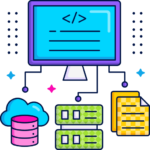pricing Plans
The Best Solutions for Our Clients
offers competitive rates and pricing plans to help you find a plan that fits the needs and budget of your business.
Basic Plan
Tritani periculis vix an. At eam nostrud eruditi, his quem purto nulla an.
Premium Plan
Tritani periculis vix an. At eam nostrud eruditi, his quem purto nulla an.
Standart Plan
Tritani periculis vix an. At eam nostrud eruditi, his quem purto nulla an.
OUR INFRASTRUCTURE SERVICES
How We Can Help?

Security Measures in Infrastructure
Security is paramount in modern infrastructure design. Encryption protocols safeguard sensitive data during transmission and storage, while access control systems ensure that only authorized personnel can access critical resources. Intrusion detection systems (IDS) provide real-time monitoring for potential threats, enhancing overall network security and integrity.

Scalability and Flexibility
The ability to scale infrastructure resources dynamically is crucial for meeting fluctuating demands. Horizontal scaling involves adding more identical resources, such as servers, to distribute workloads efficiently. Vertical scaling increases the capacity of existing resources, such as upgrading server hardware. Cloud infrastructure offers elasticity, allowing businesses to scale resources up or down based on demand, optimizing cost-efficiency and performance.

Monitoring and Management Tools
Effective management of infrastructure relies on comprehensive monitoring and management tools. Network monitoring tools track traffic patterns and performance metrics, identifying potential issues before they impact operations. Resource utilization tools optimize resource allocation, while incident management systems streamline response efforts to minimize disruptions.

Integration with DevOps Practices
DevOps principles emphasize collaboration between development and operations teams to automate and streamline infrastructure management. Continuous integration (CI) ensures frequent code updates, while continuous deployment (CD) automates software releases. Infrastructure as Code (IaC) treats infrastructure configurations as code, enabling automated provisioning and management.

Impact of Infrastructure on Performance
Infrastructure directly influences performance metrics such as speed, latency, and reliability. High-performance infrastructure reduces latency in data access and processing, enhancing user experience and operational efficiency. Reliable infrastructure ensures consistent service delivery, meeting uptime requirements and maintaining customer satisfaction.

Cost Considerations
While investing in robust infrastructure yields significant benefits, businesses must consider both initial setup costs and ongoing maintenance expenses. Cloud solutions offer scalability without upfront investments in physical hardware, while traditional setups may require substantial capital for infrastructure procurement and maintenance.
INFRASTRUCTURE Services
● In-house infrastructure
● Containerization
● Orchestration
● Converged and hyperconverged
 In-house infrastructure refers to the IT hardware and software resources that an organization owns and operates within its own premises. This traditional setup includes servers, storage devices, networking equipment, and the necessary software to manage and run these resources.
In-house infrastructure refers to the IT hardware and software resources that an organization owns and operates within its own premises. This traditional setup includes servers, storage devices, networking equipment, and the necessary software to manage and run these resources.
In-house infrastructure provides full control over the systems and data, which is crucial for organizations with specific regulatory or security requirements. It’s like owning a house: you have the freedom to renovate, expand, or redecorate according to your needs.
Once you’ve got a strategy in place, it’s time for implementation. This is where your plans come to life.
Faq
Most Popular Questions
AIn-house infrastructure is owned and managed by the organization on its premises, while cloud infrastructure is hosted and managed by third-party providers, offering scalability and flexibility without the need for significant upfront investment.
Advantages of In-House Infrastructure
There are several advantages to maintaining in-house infrastructure:
- Full Control: Organizations have complete control over their hardware, software, and data.
- Customization: Systems can be tailored to meet specific business needs.
- Security: Enhanced security measures can be implemented to protect sensitive data.
- Compliance: Easier to comply with industry-specific regulations and standards.
However, it’s not without its challenges.
Challenges of In-House Infrastructure
Despite its benefits, in-house infrastructure can be challenging:
- Cost: High upfront investment in hardware and ongoing maintenance costs.
- Scalability: Difficult to scale quickly in response to growing business needs.
- Management: Requires skilled personnel to manage and maintain the infrastructure.
- Downtime: Higher risk of downtime due to hardware failures or maintenance activities.
To address these challenges, many organizations are turning to modern solutions like containerization.
The Rise of Containerization
Containerization is a lightweight form of virtualization that allows applications to run in isolated environments called containers. These containers include everything needed to run the application, such as the code, runtime, libraries, and settings. Think of it as packing everything you need for a trip into a single, compact suitcase.
Benefits of Containerization
Containerization offers several key benefits:
- Portability: Containers can run consistently across different environments, from a developer’s laptop to a production server.
- Efficiency: Containers are lightweight and use fewer resources than traditional virtual machines.
- Scalability: Easy to scale applications by adding or removing containers as needed.
- Isolation: Each container runs in isolation, reducing the risk of conflicts between applications.
With the increasing adoption of containers, the need for effective orchestration has also emerged.
Introduction to Orchestration
Orchestration refers to the automated management, coordination, and arrangement of complex computer systems, middleware, and services. In the context of containerized environments, orchestration tools help manage the lifecycle of containers, ensuring they run smoothly and efficiently.
Popular Orchestration Tools
Several orchestration tools are widely used in the industry:
- Kubernetes: The most popular container orchestration platform, known for its scalability and flexibility.
- Docker Swarm: A native clustering and scheduling tool for Docker containers.
- Apache Mesos: A distributed systems kernel that abstracts CPU, memory, storage, and other resources away from machines.
Orchestration simplifies the deployment and management of applications, making it easier to maintain high availability and performance.
Converged vs. Hyper-Converged Infrastructure
Converged infrastructure integrates compute, storage, and networking into a single, cohesive system. This approach simplifies management and improves efficiency by reducing the complexity of traditional multi-vendor environments.
Hyper-converged infrastructure takes this a step further by incorporating virtualization and software-defined storage into the same platform. It’s like upgrading from a well-organized closet to a smart closet that automatically sorts and manages your clothes.
Benefits of Converged Infrastructure
Converged infrastructure offers several advantages:
- Simplified Management: Centralized management reduces administrative overhead.
- Cost Savings: Lower costs due to reduced hardware and maintenance requirements.
- Improved Performance: Optimized for performance with integrated components.
- Scalability: Easier to scale by adding more nodes to the system.
Hyper-Converged Infrastructure Explained
Hyper-converged infrastructure (HCI) builds on the principles of converged infrastructure but adds more flexibility and scalability. HCI integrates compute, storage, and networking with a hypervisor and software-defined storage, all managed through a single interface.
Key benefits of HCI include:
- Unified Management: Single pane of glass for managing all resources.
- Scalability: Scale-out architecture allows for easy expansion by adding nodes.
- Efficiency: Improved resource utilization and reduced waste.
- Flexibility: Easily adaptable to changing workloads and business needs.
Choosing the Right Infrastructure
Choosing the right infrastructure depends on several factors, including:
- Business Requirements: Assess your specific needs and objectives.
- Budget: Consider both upfront and ongoing costs.
- Scalability: Ensure the infrastructure can grow with your business.
- Management: Evaluate the skills and resources available for management and maintenance.
It’s essential to weigh the pros and cons of each option to find the best fit for your organization.
Future Trends in Infrastructure
The infrastructure landscape is continuously evolving. Here are some trends to watch:
- Edge Computing: Bringing computing closer to the data source for faster processing and reduced latency.
- AI and Machine Learning: Integrating AI and ML to optimize infrastructure management and operations.
- Serverless Computing: Allowing developers to focus on code without worrying about the underlying infrastructure.
- Hybrid Cloud: Combining on-premises infrastructure with public and private clouds for greater flexibility.
Staying ahead of these trends can help your organization maintain a competitive edge.
Conclusion
In the ever-changing world of IT, understanding and implementing the right infrastructure is crucial for success. Whether you choose in-house infrastructure, containerization, orchestration, or converged and hyper-converged systems, each has its own set of benefits and challenges. By carefully assessing your needs and keeping an eye on future trends, you can build a robust, efficient, and scalable infrastructure that supports your organization’s goals.
AContainerization allows applications to run consistently across different environments, simplifies scaling, and reduces resource usage compared to traditional virtual machines.
AOrchestration automates the management of containerized applications, ensuring efficient resource utilization, high availability, and simplified scaling and updates.
AHyper-converged infrastructure offers unified management, improved scalability, better resource utilization, and greater flexibility compared to traditional, multi-vendor environments.
AEdge computing processes data closer to its source, reducing latency and bandwidth usage, and enabling faster decision-making for applications requiring real-time processing.
Best for you
How CUSION Team Can Help
JOIN A WORLD-CLASS TEAM OF VISIONARY CREATORS AND CUTTING-EDGE INNOVATORS DRIVING
THE FUTURE OF INDUSTRY AND TECHNOLOGY.
analysis
Get Free INFRASTRUCTURE Analysis?
Experience CRM Analytics for free. Harness intelligent recommendations to make faster, more informed decisions and uncover actionable insights tailored to your business needs.








